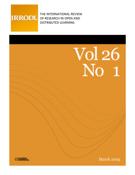EN:
Peer-to-peer interaction using computer-mediated communication (CMC) would appear to be a promising source of timely and cost-effective student support, but little empirical evidence regarding actual participant support behaviour has been presented (Lee, 2000). This paper reports a study of the occurrence of 13 online strategies defined as “supportive,” according to the categorizations found in an instrument called the Transcript Analysis Tool (TAT). The corpus used in the study consisted of three transcripts produced by students (graduate degree and professional development diploma candidates) engaged in course-related CMC conferencing. Analysis of the transcripts generated by the three groups showed the following:
The support strategies most frequently used by the three groups were referential statements (statements which made reference to others’ previous comments; TAT type 2B), signatures, greetings, and horizontal questions (open-ended questions which invited negotiation of a plausible answer; TAT type 1B).
There was some variability among the groups in the frequency of use of referential statements, horizontal questions, emoticons, and invitations to others.
High- and low-support groups differed from each other in their use of referential statements, signatures, greetings, horizontal questions, rhetorical questions, and humour.
As an examination of the social element of three communities of inquiry, the study described how members of these groups attempted to connect with one another interpersonally, using asynchronous conferencing, on topics related to the conceptual content of the courses. The paper concludes that while in this case the above behaviours were the means most often used to support and encourage interaction, further examination of online support behaviours and strategies is needed, especially in relation to valued outcomes such as persistence, greater motivation, less stress, and, ultimately, enhanced learning.





